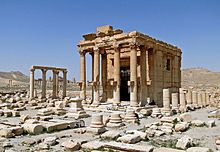معبد بعل شمين | |
 The Temple of Baalshamin in 2010 | |
| Location | Palmyra, Syria |
|---|---|
| Coordinates | 34°33′12″N 38°16′12″E / 34.553401°N 38.269941°E |
| Type | Temple |
| History | |
| Material | Stone |
| Founded | 131 AD |
| Cultures | Palmyrene |
| Site notes | |
| Excavation dates | 1954–1956 |
| Condition | Restored, August 2015 |
| Ownership | Public |
| Public access | Inaccessible (in a war zone) |
| Type | Cultural |
| Criteria | i, ii, iv |
| Designated | 1980 (4th session) |
| Part of | Site of Palmyra |
| Reference no. | 23 |
| Region | Arab States |
| Endangered | 2013–2015 (destroyed) |
The Temple of Baalshamin was an ancient temple in the city of Palmyra, Syria, dedicated to the Canaanite sky deity Baalshamin. The temple's earliest phase dates to the late 2nd century BC;[1] its altar was built in 115 AD,[2] and the temple was substantially rebuilt in 131 AD. The temple would have been closed during the persecution of pagans in the late Roman Empire in a campaign against the temples of the East made by Maternus Cynegius, Praetorian Prefect of Oriens, between 25 May 385 to 19 March 388.[3] With the spreading of Christianity in the region in the 5th century AD, the temple was converted to a church.[4]
In 1864, French photographer and naval officer Louis Vignes was the first to photograph the temple following his expedition to the Dead Sea under the sponsorship of the Duc du Luynes.[5]
It was one of the most complete ancient structures in Palmyra.[4] In 1980, UNESCO designated the temple as a World Heritage Site.
In 2015, the Islamic State of Iraq and the Levant demolished the Temple of Baalshamin after capturing Palmyra during the Syrian Civil War.
- ^ Bryce, Trevor (2014). Ancient Syria: A Three Thousand Year History. Oxford University Press. p. 276. ISBN 978-0-19-964667-8. LCCN 2013942192.
- ^ Stoneman, Richard (1994). Palmyra and Its Empire: Zenobia's Revolt Against Rome. University of Michigan Press. p. 65. ISBN 0472083155.
- ^ Trombley, Hellenic Religion and Christianization c. 370-529
- ^ a b Darke, Diana (2010). Syria. Bradt Travel Guides. p. 271. ISBN 978-1841623146.
- ^ France Terpak and Peter Louis Bonfitto. "Louis Vignes". The Legacy of Ancient Palmyra. The Getty Research Institute. Retrieved 10 February 2017.
